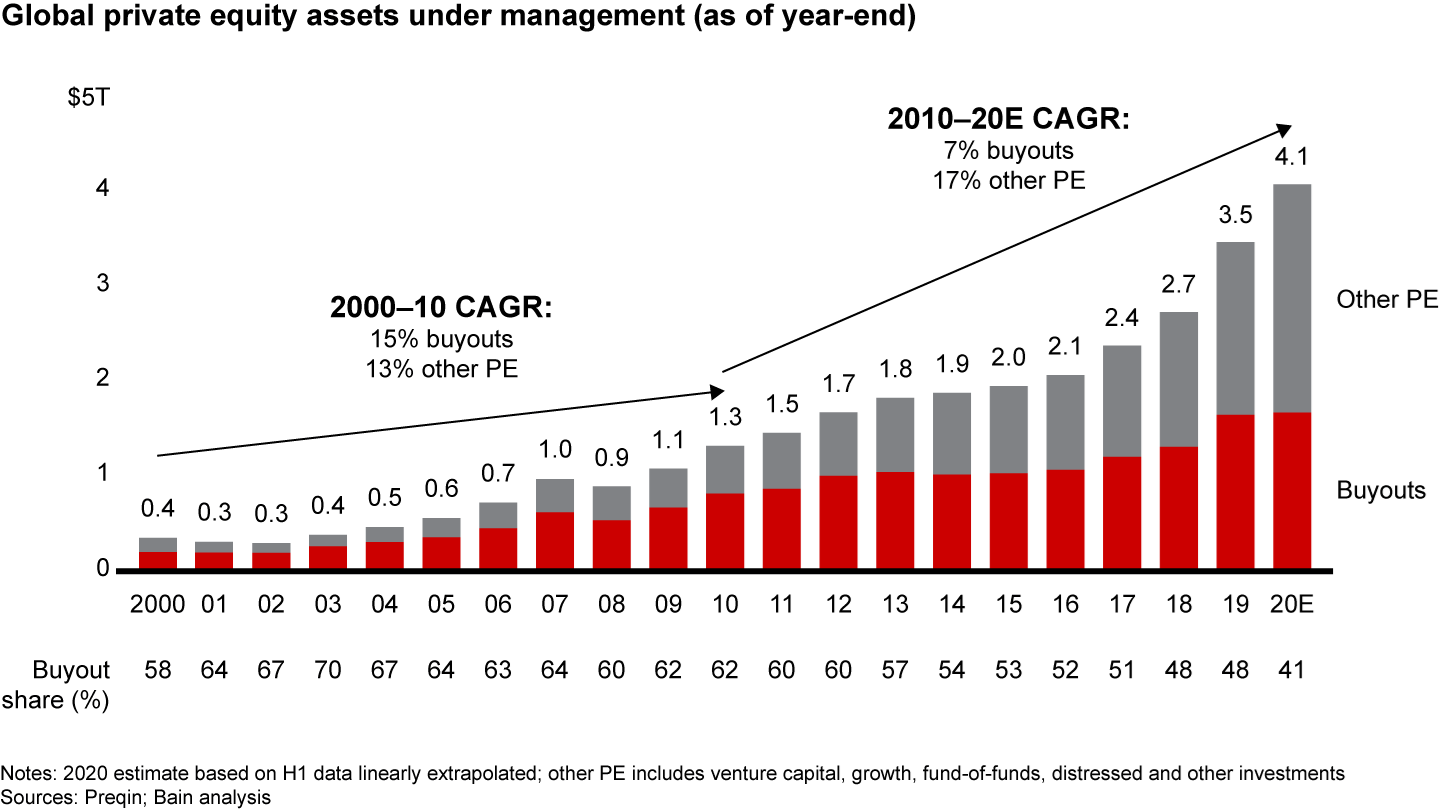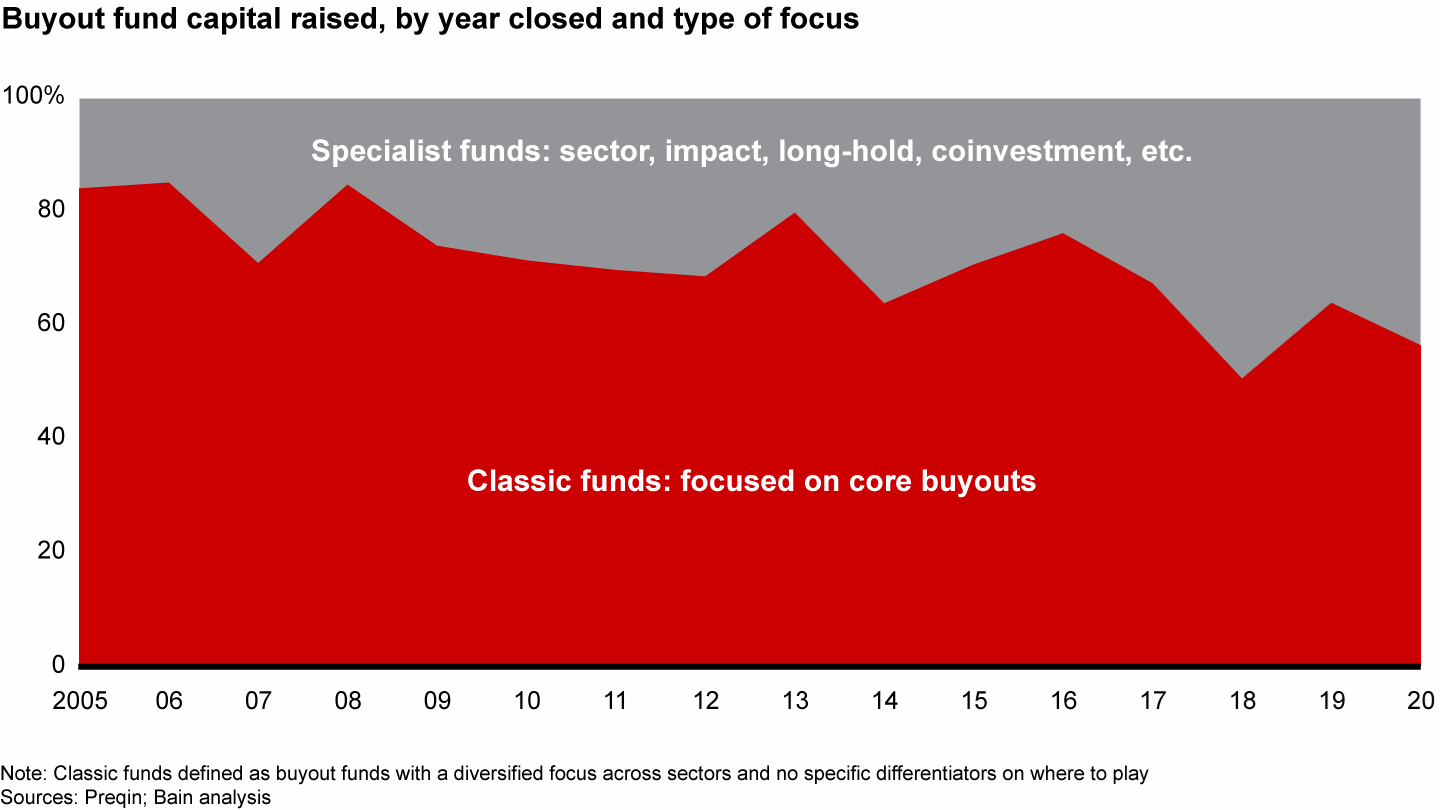Global Private Equity Report

Executive Summary
- Once the private equity industry standard, classic buyout funds are ceding ground to specialists.
- That’s pressuring a broad swath of funds in the market’s middle to find new ways to differentiate themselves.
- Options abound, but choosing the right strategy starts with five key areas of inquiry.
This article is part of Bain's 2021 Global Private Equity Report.
For more than 30 years, buyout firms have stood at the center of the private equity industry. For the last 10, that position has been slipping.
While assets under management (AUM) held by buyout funds grew 7% compounded annually during the industry’s historic expansion over the past decade, other private equity asset classes grew more than twice as fast. Investors piling into categories like growth, venture capital and distressed assets have powered 17% annual growth in nonbuyout alternatives since 2010, building to an estimated $2.4 trillion in AUM by the end of 2020. Buyouts are still the industry’s single largest category, but their share of assets is shrinking. Buyout funds held 41% of global private equity AUM in 2020, down from 62% in 2010 (see Figure 1).
Buyout fund growth has slowed as more and more capital flows to other private asset classes


Growth within the buyout category has also shifted significantly. For the first two-thirds of private equity’s relatively brief history, the industry was shaped by the classic buyout fund, one geared to hunt for value in a number of industries and sectors with a diversified portfolio. Since 2010, however, these classic funds have been losing share to specialists—firms that have carved out clear areas of expertise and exploited them aggressively, including hyperfocused subsector funds, growth funds, ESG specialists, long-hold funds, etc. The share of capital raised for classic funds has slipped from a recent peak of 80% in 2013 to 56% at the end of 2020 (see Figure 2).
Within the buyout category, funds with classic strategies are losing ground to specialists


Market forces are driving the shift. Amid fierce competition for targets, some general partners have developed specialized capabilities to generate the kinds of proprietary insights that win multibidder auctions. At the same time, limited partners have become more discerning with their strategies. Having once pursued a straight-ahead PE allocation, LPs are now looking to plug specific holes in their alternative asset allocations or address specific requirements (such as sustainability standards) from their stakeholders. One result: Investors are funneling more capital to GPs that offer something different through both performance and focus.
Extending this trend line out another 5 or 10 years strongly suggests that classic buyout funds may have a harder time attracting new capital than they have in the past. That’s prompting many firms to ask themselves a fundamental strategic question: How do we increase the value of our business over time?
The uncomfortable middle
For years, the path to alpha was clear. Adding value to the general partnership meant raising a bigger fund and doing more buyouts wherever you could find the best opportunities.
As the industry grew and became more crowded, firms developed expertise in certain industries or geographies while honing value-creation models. But the evolution was relatively slow and the market relatively forgiving; lower average multiples meant it was easier to underwrite risk and recover quickly when firms got it wrong. As long as they performed and continued to raise capital for bigger and bigger funds, full steam ahead.
Unprecedented growth in AUM, fierce competition for assets and chronically high price multiples have turned up the heat on firms to find deeper insights.
The last five years or so have been a different story. Unprecedented growth in AUM, fierce competition for assets and chronically high price multiples have turned up the heat on firms to find deeper insights, develop a better playbook and attract the best talent. That and a growing preference for specialization among LPs have led to a rapid expansion of innovative new fund types. Sector funds have given way to even more focused subsector funds. LPs are pouring money into growth equity funds, tactical opportunity funds, long-hold funds, and ESG-focused and impact funds. Even the recent explosion in SPACs reflects the scramble for targeted solutions. It’s not that there’s a need for more capital. What the market is craving are clever new ways to find and create value.

SPACs: Tapping an Evolving Opportunity
Here’s how the controversial explosion in special-purpose acquisition companies is unfolding.
This presents a special challenge for classic buyout firms in the market’s middle. On one flank, they are competing with diversified giants—funds like Blackstone, KKR and Carlyle that have permanent sources of capital, products in most segments and the resources to launch new ones with minimal risk to the business. On the other, they face innovative new funds that are scrappy, entrepreneurial and hatched with differentiated strategies specifically tailored to current fund-raising trends.
These specialists are hitting the market in a steady stream. London-based Corten Capital, for instance, raised $435 million in 2020 (27% more than it targeted) for a portfolio narrowly focused on technology-driven B2B services. Formed by a team of two ex-Warburg dealmakers and two successful technology executives, the fund specifically seeks out entrepreneurially managed companies that provide mission-critical services and software solutions that are deeply embedded in customer workflows.
Another example is Cove Hill Partners, which launched in 2017 as a long-hold fund focused on only two sectors: consumer and technology. Having raised more than $1 billion in September 2017 after just three months on the road, it raised another $1.5 billion in July 2020, despite the fact it had yet to sell a company from the original portfolio or produce a realized return.
Hugh MacArthur discusses the trends private equity investors should consider as the pace of innovation continues to accelerate.
Decision time
This landscape presents many buyout firms with a set of important questions. First among them: With asset prices sky high and in no danger of falling, how can we continue to generate attractive returns unless we find a differentiated advantage, especially now that many LPs expect it? Moreover, how are we going to pay for it? Unlike the largest firms that can shift investment and resources to a new strategy without taking much risk, investing in a new product and building new capabilities can be a bet-the-firm decision for a midsize player. That’s not easy, especially when performance is still holding up.
Making a bold move, however, can transform a firm’s business. Consider Vista, which in 2000 started as a $1 billion fund focused on buying legacy software companies and making them more efficient. Recognizing that staying ahead in this red-hot industry would require deeper expertise, Vista expanded its horizons over time by moving into asset-class adjacencies within the sector that would help the firm participate in the complete software growth cycle.
With asset prices sky high and in no danger of falling, how can we continue to generate attractive returns unless we find a differentiated advantage?
Since 2010, it has launched several growth-equity funds to capture opportunities among rapidly growing adolescent software companies. In 2014, it expanded beyond equity to create a fund to supply credit solutions to enterprise software, data and technology-enabled businesses. It also launched a public equity long/short fund focused on tech, media and telecom companies. In January 2021, it raised $2.4 billion for a new long-hold fund that offers investors extended investment periods and long-term, consistent dividends.
This diversification within the software sector—which began when Vista asked itself, “How can we grow and add value to the general partnership?”—has created a software specialist with few industry peers. By radiating out and creating a distinctive ecosystem of private-market products, Vista has found an edge in one of the most attractive and competitive sectors in the global economy. The firm now has more than $73 billion in assets under management, and in September 2019 it closed its seventh fund, worth $16 billion. Its growth and success have inspired a number of other technology specialists, many of whom are scaling fast.
Two other good examples of classic buyout firms that have prospered as specialists are Audax Group and Roark.
Audax has become a tightly focused buy-and-build specialist. Since 1999, it has raised more than $9 billion aimed at acquiring middle-market companies clustered largely in three specific industries—healthcare, technology and business services. That has involved investing to build a team that is expert at finding the right acquisitions and adding on legal and financial teams capable of processing transactions quickly. The result is a firm that can move faster and more insightfully than others to create value through multiple arbitrage: finding promising platform companies and rolling up low-multiple acquisitions to build a company with a higher multiple.
Roark developed a focus on investments in consumer and business services companies, with a specialization in franchise and multilocation business models. It has acquired 90 franchise or multilocation brands across industries, from restaurants (Arby’s and Jimmy John’s) to auto care (Maaco and Meineke). The firm has become expert in supporting brand growth, improving store execution, structuring franchise economics, and avoiding the many duds that either don’t stand out from the crowd or have limited growth prospects. Its distinctive approach has attracted $20 billion in AUM.
Avoiding stall-out
Bold moves like these begin with the realization that what worked over the past 20 years may not work as well in the coming 10. A market that clearly favors differentiated expertise requires firms to carefully assess what is going to make them stand out.

The Expanding Case for ESG in Private Equity
Customers, employees and limited partners are demanding more sustainable, socially conscious corporate behavior. PE firms that can deliver are reaping the rewards.
Firms that have successfully charted a new path for growth in the coming decade follow a logical sequence. They first define (with facts) where the firm is now, spelling out its core repeatable model for generating value. From that starting point, they focus their strategic inquiry in five areas:
- How can we adopt new products and adjacencies that capitalize on our strengths?
- Which sectors or subsectors are we prepared to go deep on—and really mean it?
- How can we use data, digital and advanced analytics to transform how we find and evaluate targets?
- What is our value-creation playbook, and is it both digitally enabled and distinctive?
- What is our ESG strategy, and do we truly understand how shifting consumer and employee motivations are changing the calculus for success in almost every industry?
Private equity investors have built an industry on the principle that hewing to the status quo is rarely a formula for creating new value. For many classic buyout funds, decision time is fast approaching.